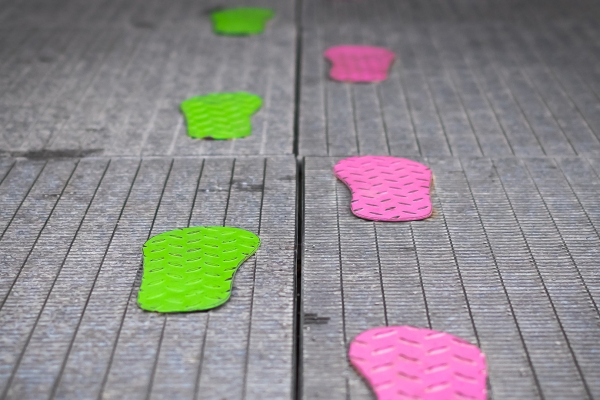
Me in my apron. Let’s just say it’s a good thing I do social media for a detergent brand.
My sister might ruin everything, but she is also excellent at presents. Back in March, she got me a gift certificate for the amazing Bettys Cookery School (no, there isn’t an apostrophe; yes, it bugs me). Based in Harrogate, Yorkshire – also home to the first Bettys tearoom – the school offers a multitude of cooking courses for all levels of ability.
We opted for a Christmas-themed course; growing up Greek, fruit cakes and puddings weren’t really part of our frame of reference. My mum’s gorgeous but distinctly light and un-fruity chestnut cream gateau and an M&S trifle were more the order of the day. Thus, going to the most quintessentially British (alright, English) place we could think of to make quintessentially British Christmas goodies was very appealing, and likely to mean we really learned something.
The School & Courses

Some of the beautiful array made by James
Bettys Cookery School sits alongside the craft bakery which supplies the famous tea rooms and the online shop, which posts items out across the world. This Christmas they’ve already made tens of thousands of puddings and cakes, and are set to supply around a quarter of a million mince pies far and wide – with orders from as far away as Australia (and really, you can’t get much further). The mince pies in particular are a great favourite of mine, as last year’s head-to-head with Riverford showed!
The course room is a large, well-stocked kitchen with huge granite worktops, gas hobs and electric, fan-assisted ovens. It accommodates around 20-25 cooks, working three to a counter. There’s also a small shopping area with items from the bakery and the cookshop, and a large area with tables at which to take food breaks.
Tutors could be full-timers at the school or staff from the bakery. We had David Haynes from the former group and James Proudfoot from the latter. We also had a ‘host’, Helen, who made sure tea and coffee were plentiful, arranged all the food breaks, welcomed us in and processed any shop orders.
Courses at the school range from half-day ‘mini’ sessions for around £100 to full week-long certification courses up to £1,600. We did a full day, priced at £180, which includes breakfast, lunch and two tea breaks, an apron, a course folder with all the day’s recipes (plus extras if appropriate), whatever you need to take your creations home – in our case a ceramic pudding bowl, three glass jars and various cardboard boxes, plastic tubs and paper bags.
The only thing you need to bring is washing up gloves if you need to use them, as you’ll be clearing up after yourself.
Christmas Cakes & Puddings
On this course we made:
A Christmas pudding
A Christmas cake
3 x 300g jars of mincemeat
A mincemeat streusel tart
A sizeable tub of rum sauce

Afternoon tea break!
All ingredients were provided, including chilled and rested pastry for the tart; there wasn’t time to make our own that day, but the recipe was included in our folders. Ingredients were already weighed, measured and bagged up neatly on trays, and if there was any excess (we zested a lot of lemons and oranges, but didn’t juce them all), were were invited to take this away with us.
When we arrived, we were given half an hour to settle in, grab our aprons and enjoy some buttery, crisp, achingly fresh croissants from the bakery, with lightly salted butter and Bettys jam, plus as much Yorkshire tea or Taylor’s of Harrogate coffee as we could manage. We sat in groups of six around tables, and introduced ourselves to others on the course; though it’s a lovely thing to do as a pair, everyone was so friendly I wouldn’t have felt awkward alone. It was a real mix of newbies and regulars; one woman came with her mum who, whilst new to Bettys Cookery School, already had FOURTEEN Christmas cakes maturing in her cupboards at home (for the record, she still picked up a new tip or two!).

Poached salmon and veggies – just waiting to add spuds!
We then gathered around the demo table for the first walk-through – the pudding, and sterilising the jars. Our ovens were already set for us, and nicely to temperature, so we could get straight into hands on – or rather hands in – mixing and washing up our jars so we could pop them in. Once our puddings were neatly packed into their bowls, topped with the pre-cut baking parchment discs we were provided with and trussed up in foil on the hob, we had our first tea break, with hazlenut swirls and chocolate cookies. David and James floated around to help, and during our tea break they ensured all the puddings were turned down to a simmer.
After tea we got to work on the cake, and we seriously earned our lunch. The tutors prefer it to be made by hand so you can understand what’s happening and why; just as well, as nearly all of us managed to have some curdling towards the end of our egg addition. My hands got so buttery from stirring and scraping, I actually have a blister at the base of my little finger! James, who has turned out thousands upon thousands of cakes, took a good half hour to demonstrate the mixing, so you can imagine how long it took us! We picked up great tips, like using glycerine for moistness and making sure the cake is carefully levelled to stop fruit popping out and burning, leaving a bitter taste. We also discovered that the whole wrapping-up-in-brown-paper thing is not only unnecessary but actively detrimental, as it increases the baking time and therefore dries out the finished cake.

Mincemeat streusel tarts – mine is the star, my sister’s the tree.
After quickly mixing and transferring the mincemeat recipe to the jars, we washed up for a delicious lunch of poached salmon, new potatoes and ratatouille, followed by a dark chocolate bombe concealing a gooey, passionfruit caramel centre (bascially a very posh jaffa cake). We also got a lovely glass of Swiss wine in the colour of our choice.
After lunch, we embarked on the streusel tart, which mostly meant rolling out pastry and making a crumble topping, and then the incredibly moreish rum sauce. I finally understand how to make a decent roux! While the tarts were baking we squeezed in another tea break with generous slabs of lemon drizzle cake, and then tasted Jame’s pudding and a Christmas cake that had been maturing in the bakery for a couple of weeks. We also learned that you should never cut a fruit cake with a flat-edged knife, as the pressure really messes up the texture and makes it appear dry; always use a serrated edge and saw gently. Seeing the two freshly cut slices in front of us and the difference in appearance was seriously surprising.
Verdict
I was really excited to go to the school, and I wasn’t disappointed. Although it was a gift, it would have been well worth paying for as it was extremely good value, even taking into account the trip up from the South East (although I do have free accommodation in Yorkshire!). There are a few courses I wouldn’t try, as with the right recipes I’d feel I’m an experienced enough baker to just experiment at home, but as I have absolutely no idea about mincemeat and fruit cakes it was pretty perfect. There are also advanced courses if you’re already quite proficient, plus things like knife skills and several savouries courses, not just baking.
My plan is to save up (or make Christmas / birthday cow eyes) for the breadmaking basics, as I think that’s something where it’s really helpful to have an experienced guide tell you what you should be looking for in terms of texture. Plus it’s a skill I can see me putting to good use at home on a regular basis.
















